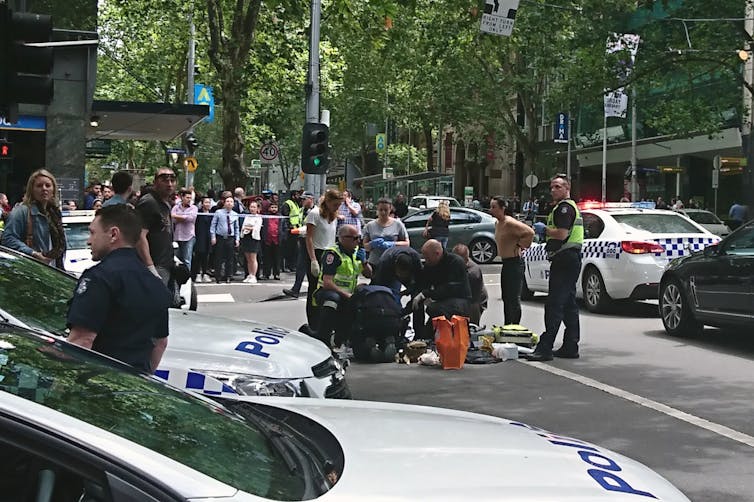Recent attacks in Westminster and Stockholm, following attacks last year in Nice and Berlin, have shown the world a terrifying terrorist tactic. Attackers have driven vehicles into crowds of people, killing and injuring many.
In Australia, the Bourke Street Mall attack also showed the devastation that can be caused when a vehicle is used as a weapon. Yet the events overseas have been clearly labelled as terrorism, whereas the Melbourne incident is considered a “massacre”, “rampage”, and “tragedy”. The accused has been charged with six counts of murder, but not any terror-related offences.
Last week, three people were seriously assaulted and a service station employee was stabbed to death in Queanbeyan, near the ACT/NSW border. The two accused are facing murder, robbery and serious assault charges. No terror charges have been laid, even though the crimes were investigated by counter-terrorism police and one of the accused may have had terror links.
So, what makes some killings of innocent people acts of terrorism, and others not?
Defining terrorism
The international community has not agreed on a formal definition of terrorism. Efforts to draft a comprehensive international convention on terrorism have continually stalled.
However, Australia and most other countries do have their own definitions of terrorism in domestic law. In Australia, a “terrorist act” is defined as an action or threat that:
a) is intended to advance a political, religious or ideological cause; and
b) is intended to coerce or influence a government by intimidation, or intimidate a section of the public; and
c) causes one in a list of specified harms, including death, serious injury, or serious property damage.
Many criminal offences, including preparing terrorist acts and possessing “things” connected with terrorist acts, rely on this definition.
The first requirement – the intention to advance a political, religious or ideological cause – is commonly referred to as a “motive” requirement. This is key to distinguishing some attacks, like that in Bourke Street, from terrorism. The prosecution would not likely be able to prove a religious, political or ideological motive behind that attack.
In addition, while that attack certainly intimidated the public, the prosecution may not have been able to prove this was its intended effect.
Decisions to prosecute
In other cases, charges for terrorism, murder or serious assault may all be viable. The police and prosecution will decide which charges to pursue in court. This decision will depend heavily on which charges present the greatest chance for a successful conviction.
Murder and assault charges may be preferred because the terrorism laws contain extra hurdles. The offence of murder has the same maximum penalty as many terrorism offences: life imprisonment. But it does not require the prosecution to prove the offender had a special motive or intention.
At the same time, the police and prosecution can lose some advantages in choosing not to pursue terrorism charges. Terrorism offences provide longer periods of pre-charge detention, and they allow classified information to be admitted in summary or redacted form as evidence in court.
Media reporting will be influenced by these decisions and the information provided by police. Media outlets will be careful not to report on something as a “terrorist act” if it is not to be treated as such in court. There may not be a fair trial if a jury sees media reports and unfairly associates a defendant with terrorism.

Connection to terror groups
Another key factor is whether the attacker has a direct connection to a terrorist group like Islamic State (IS).
If the attacker has fought with, recruited for or funded IS, many terrorism offences will be available and easier to prosecute. This is because IS is a listed terrorist organisation, and is clearly engaged in terrorism overseas.
In the attack’s aftermath, it is frequently uncertain whether an attacker is connected with IS, or if IS is simply making a post-hoc claim for responsibility. This creates difficulties in how to categorise an attack, and can continue for some time after the event.
Community needs
Finally, there are good reasons why the media, government and general public may prefer to call an attack a “murder” rather than “terrorism” – or an attacker a “gunman”, rather than a “terrorist”.
These less-emotive labels can reduce the possible media hype associated with terrorism, and avoid turning an attacker into a martyr for their cause. It is as if the community responds by saying: “You are just an ordinary criminal – not a terrorist – and we will go about our daily lives without fear”.
This resilient attitude may help communities reduce the psychological impact of terrorism. But does it encourage too great a focus on ourselves in the aftermath of an attack, and an insufficient focus on the victims of crime?
Following an attack, we will naturally look to the police for an answer to the question: “Are we safe?”. If it turns out the attack was not terrorism but “just” murder, we may feel a sense of relief that there is no ongoing threat.
The psychological impact of terrorism is real and significant. But all killing of innocent people is worthy of the strictest condemnation, whatever its underlying motive. Decisions by the police and prosecution to charge murder or other crimes instead of terrorism should not let us forget this important fact.

